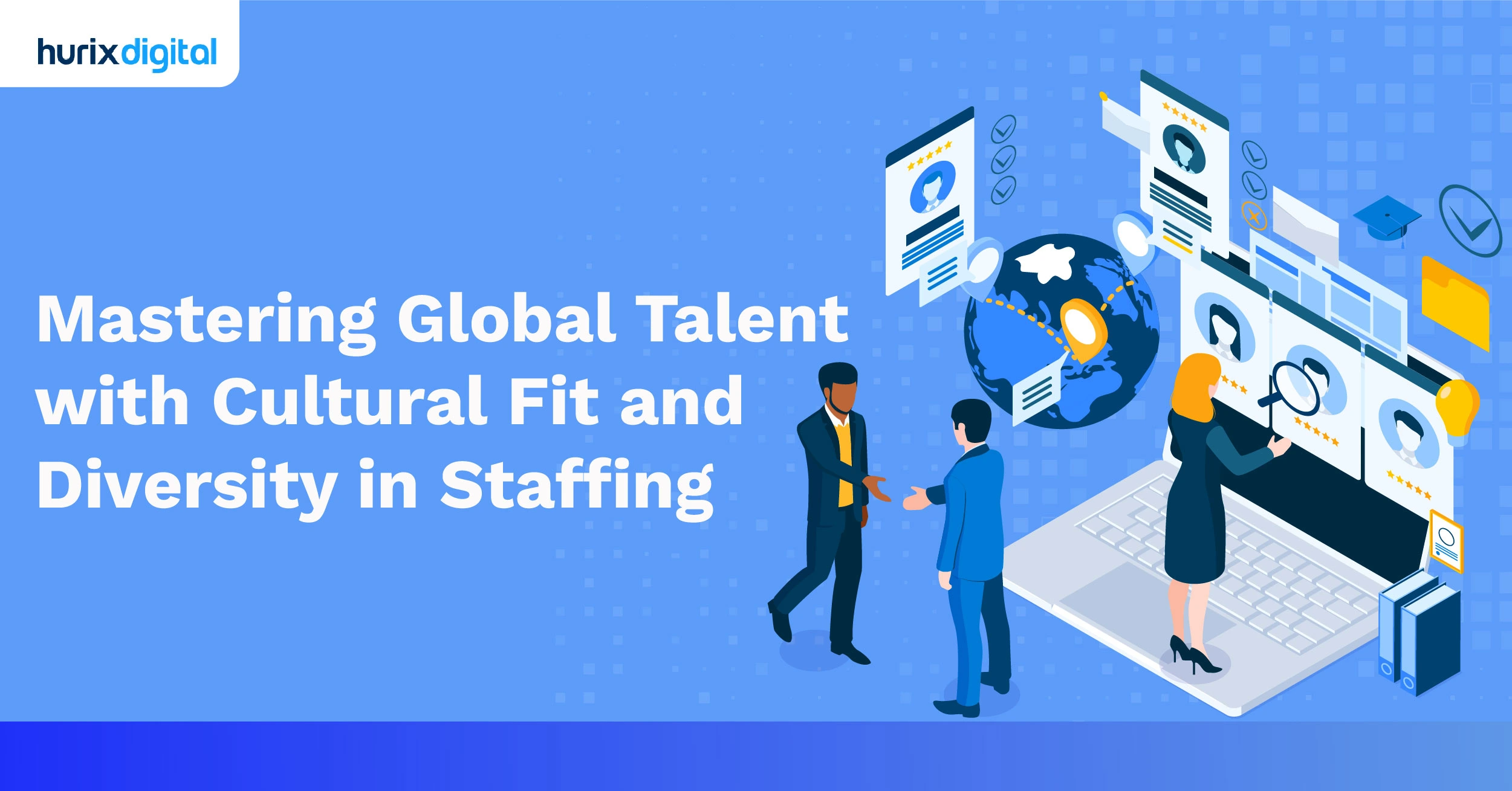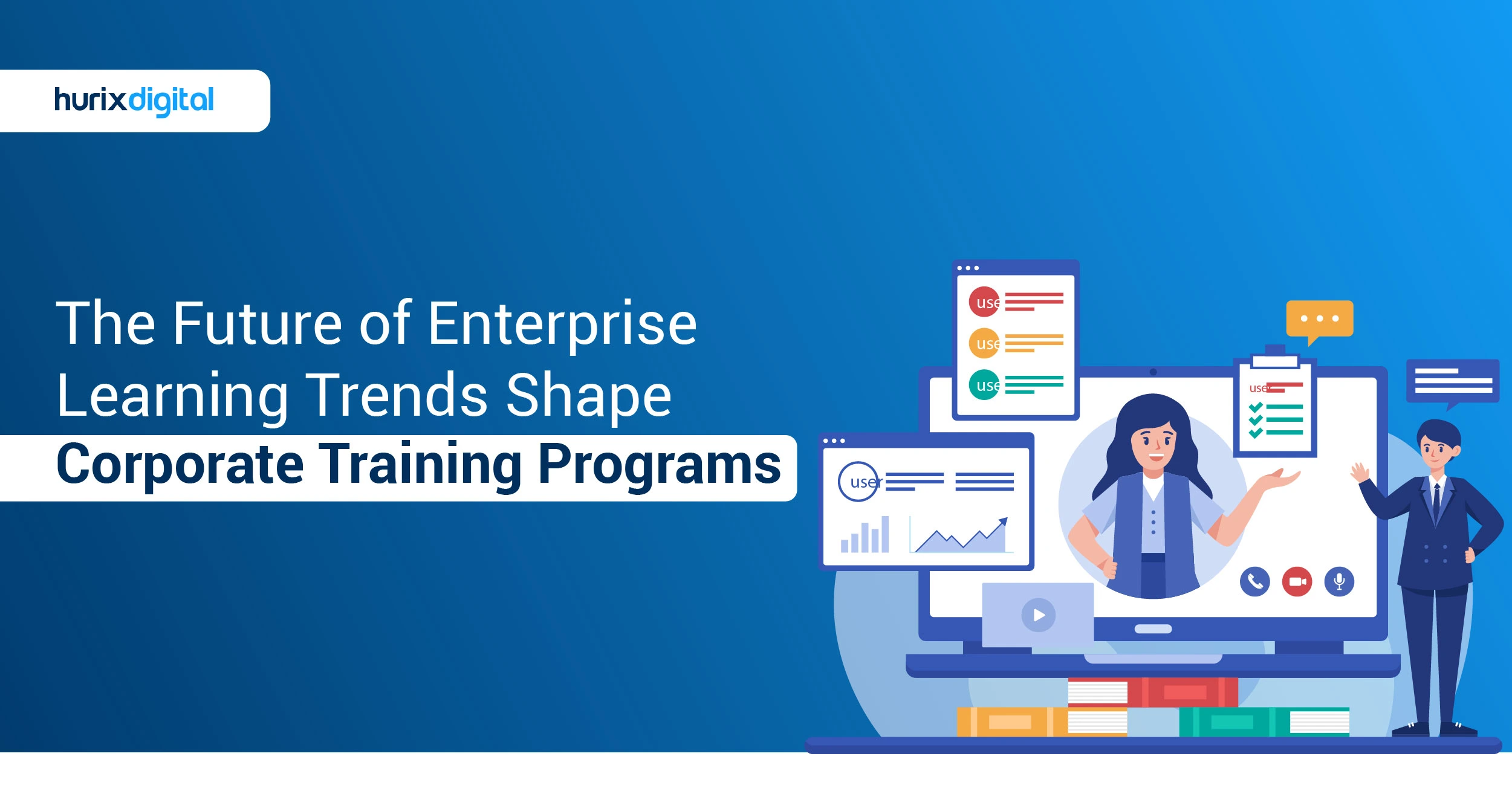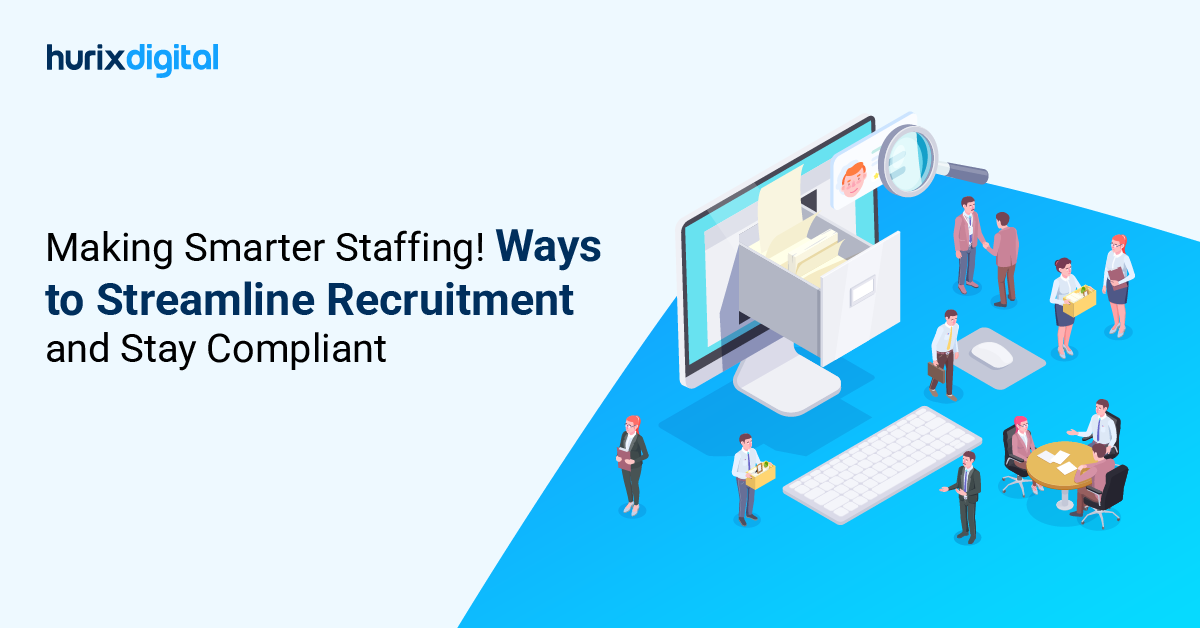
Mastering Global Talent with Cultural Fit and Diversity in Staffing
Summarize with:
With the advent of advanced technological solutions, globalization has significantly transformed hiring and talent acquisition.
Effectively managing foreign talent has become more crucial as businesses grow internationally. As a result, organizations looking to create diverse, high-performing teams across borders face opportunities and challenges regarding global staffing solutions.
Finding the right talent in today’s competitive job market presents significant challenges for organizations. One such challenge is finding an individual with the required skills who aligns with the company’s culture. Cultural fit, which refers to the degree of alignment between an individual’s values, behaviors, and attitudes and those of the organization, has become important in hiring processes.
Global Staffing Solutions prioritizes cultural fit to ensure new hires resonate with the company’s values, boosting job satisfaction, engagement, and retention. Understanding the profound impact of cultural fit is essential in the hiring process.
Table of Contents:
- What Does Global Talent Refer to?
- The Impact of Global Staffing Solutions
- What are the Key Strategies for Managing Global Staffing Solutions in 2025?
- Leveraging Technology for Global Talent Mobility
- The Power of Diversity and Inclusion in the Workplace
- What is the Role of Staffing Solutions in Promoting Diversity and Inclusion?
- What are the Top 4 Benefits of Hiring Candidates Who Fit the Company’s Culture?
- What are the Consequences of a Poor Cultural Fit?
- Evaluating Cultural Fit in the Hiring Process
- How to Leverage Staffing Solutions for Better Cultural Alignment?
- Implementing Effective Hiring Strategies for Diversity and Inclusion
- How to Build a Culture-Driven Workforce?
- Conclusion
What Does Global Talent Refer to?
All employees worldwide are collectively referred to as global talent. Attracting talent from all around the globe opens your business up to incredible opportunities. This has been possible due to the impacts of globalization and the interconnected nature of today’s world.
Thanks to communication devices and remote work, you can easily outsource remote teams and workers from your workplace these days. This also eliminates the onboarding and facilitation expenses typically associated with hiring internal employees.
Being part of an international team allows employees to be mobile and not be restricted to an office. Offering this kind of flexibility will make it simpler for you to draw in and retain the best talent.
The Impact of Global Staffing Solutions
In the modern, interconnected world, talent has no bounds.
Let’s examine how global staffing solutions have evolved in response to globalization:
1. Hiring without Physical Constraints
Thanks to globalization, which has removed regional barriers, organizations can now acquire international talent. Because of technology, hiring managers can now connect with candidates anywhere in the world using online resources, live interviews, and digital tests. This promotes multiculturalism in the labor force and broadens a multitude of possibilities.
2. Initiatives for Diversity and Inclusion
Adopting the principles of inclusion is not only the right thing to do, but it also gives businesses a competitive edge in the increasingly globalized marketplace. By cultivating an inclusive culture and promoting diversity, organizations can attract top talent, improve innovation and inventiveness, and fortify their brand reputation.
3. Growing Candidate Pool
As a result of globalization, businesses now have exposure to a wider range of viewpoints, experiences, and expertise. Employers now have a database of highly qualified professionals looking for fresh possibilities and professional development in overseas markets.
4. Flexible and Remote Work
With digital platforms, companies can recruit talent worldwide and promote smooth cooperation. This versatility improves talent access and enables businesses to create dispersed teams and allocate resources as efficiently as possible.
The global staffing market is projected to reach $650 billion in 2025, marking a 5% growth from the previous year.
What are the Key Strategies for Managing Global Staffing Solutions in 2025?
To surmount the obstacles related to managing global talent, organizations must implement strategic approaches that are congruent with their worldwide business goals.
Following are some crucial tactics for effective global staffing solutions in an increasingly globalized world:
1. Cultural Competency Training
Giving staff members this kind of instruction can make them more adept at navigating cross-cultural relationships. Employees can forge closer bonds with their foreign coworkers and clients by being aware of and respectful of cultural customs and standards.
2. Global Recruitment and Retention
Skilled professionals from various backgrounds can be drawn to an organization by implementing a strong recruitment strategy targeting international talent pools.
Implementing retention strategies tailored to the needs of foreign workers, such as programs for cultural integration and career development, can also reduce attrition and raise employee engagement.
3. Cross-Cultural Communication
Good teamwork across different cultures requires clear communication. Businesses should prioritize clear communication to ensure effective collaboration across diverse cultures.
This involves investing in training and tools that facilitate understanding and dialogue among team members from various backgrounds. When communication is transparent and respectful of cultural differences, teams can collaborate more smoothly, fostering innovation and productivity.
4. Compliance and Legal Considerations
When expanding globally, businesses must comply with the regulations of each country, including immigration policies and other legal requirements.
Companies can hire legal experts or work with local HR consultants to ensure they follow all the necessary hiring and taxes laws. These professionals help businesses understand and follow the rules in different places, keeping everything running smoothly and legally.
5. Global Collaborations
Forming strategic alliances with global hiring agencies, academic institutions, and professional groups can allow organizations to access talented individuals and useful insights.
Working together with these organizations facilitates the hiring process, gives access to vetted applicants, and makes use of local knowledge in a variety of markets.
Leveraging Technology for Global Talent Mobility
Technology is essential for enhancing and simplifying the hiring process in a globalized setting. It leads to a more efficient, cost-effective, and inclusive workforce that drives organizational success in an increasingly competitive global market.
Here’s how businesses can use technology to their advantage:
1. Applicant Tracking Systems (ATS)
By putting an ATS in place, businesses can effectively oversee the whole hiring process.
An applicant tracking system (ATS) streamlines repetitive processes, fosters better teamwork, and offers data-driven insights—from posting jobs and screening applicants to organizing interviews and managing offers.
2. Video Interviews
Doing video interviews via services like Zoom or Skype streamlines and lowers the cost of the hiring process. Employers can evaluate candidates’ interpersonal abilities, cultural compatibility, and capacity for remote workforce cooperation through video interviews.
3. Data Analytics
Data analytics offers insightful information about applicant participation, hiring effectiveness, and the efficiency of various channels.
Organizations can make choices based on data, boost sourcing tactics, and spot trends in data for hiring to keep improving the hiring process over time.
4. AI-Driven Hiring Tools
Artificial intelligence (AI) is being incorporated into recruiting tools to improve the hiring process. By utilizing predictive algorithms, these tools can assist companies in locating and luring top talent from around the world and streamlining the hiring process.
The Power of Diversity and Inclusion in the Workplace
Diversity and inclusion in the workplace are not just buzzwords but crucial elements that drive organizational success. Research has consistently shown that diverse teams outperform homogeneous ones in terms of innovation, problem-solving, and overall business performance.
When individuals from different backgrounds, cultures, and perspectives come together, they bring a wealth of ideas and insights that can lead to creative solutions and better decision-making.
Moreover, a diverse workforce reflects a diverse customer base and fosters stronger client relationships. This results in business growth and increased profitability.
What is the Role of Staffing Solutions in Promoting Diversity and Inclusion?
Organizations need a comprehensive approach to hiring to fully leverage the benefits of diversity and inclusion. This is where staffing solutions play a critical role.
1. Attracting a More Diverse Talent Pool
One key advantage of partnering with a staffing agency that offers complete staffing solutions is the ability to attract a more diverse talent pool. These agencies have the expertise to craft inclusive job descriptions and create recruitment strategies that reach candidates from underrepresented groups.
By using inclusive language and leveraging diverse networks, staffing solutions providers can help businesses cast a wider net and attract candidates from diverse backgrounds, cultures, and experiences.
2. Eliminating Unconscious Bias in Hiring
Unconscious bias can hinder diversity and inclusion efforts in recruitment. Global Staffing solution providers can help organizations identify and address unconscious bias by implementing anonymized resume screenings, interviews, and diverse hiring panels.
By removing bias from the hiring process, businesses can ensure that all candidates are evaluated fairly and based on their qualifications, skills, and potential.
3. Leveraging Technology for Inclusive Recruitment
Technology plays a crucial role in modern recruitment, and complete staffing solutions providers leverage technology to promote diversity and inclusion. They use applicant tracking systems and AI-powered tools that help eliminate bias, improve candidate matching, and streamline recruitment.
These tools can also identify patterns of bias in job postings, suggest inclusive language alternatives, and ensure that diverse candidates are given equal opportunities.
4. Developing Inclusive Organizational Policies
Global Staffing solution providers not only assist in hiring diverse talent but also help organizations develop inclusive policies and practices. They can guide in creating inclusive onboarding programs, mentoring initiatives, and employee resource groups.
By fostering an inclusive culture, businesses can create an environment where all employees feel valued, respected, and empowered to reach their full potential.
What are the Top 4 Benefits of Hiring Candidates Who Fit the Company’s Culture?
Finding the right candidate to fit the company’s culture is essential to escalate your business. Below are some of the few benefits of hiring candidates who fit the company culture:
1. Enhanced Team Cohesion and Collaboration
Hiring candidates who fit the company culture promotes a sense of unity and teamwork among employees. When individuals share common values and beliefs, they are more likely to collaborate effectively, leading to a harmonious work environment where ideas flow freely.
2. Increased Employee Satisfaction and Performance
Hiring for cultural fit boosts employee satisfaction, engagement, productivity, and performance. When employees align with company values, they feel connected, motivated, and purposeful, leading to improved morale, productivity, and performance. This cultivates a positive work environment and enhances overall organizational success.
3. Higher Retention Rates and Reduced Turnover Costs
Hiring candidates who fit the company culture reduces turnover rates and associated costs. Employees who feel a strong cultural connection are more likely to stay long-term, reducing recruitment expenses and maintaining a stable workforce, which is crucial for organizational continuity.
4. Boosted Morale and Motivation Among Employees
Cultural fit hiring boosts morale and motivation within the workforce. Employees who share common values and beliefs with the organization are more enthusiastic about their work. This leads to a positive work environment where individuals are inspired to give their best and strive for success.
What are the Consequences of a Poor Cultural Fit?
Hiring employees who do not align with the company culture harms performance and well-being. Neglecting cultural fit causes low productivity, high turnover, morale issues, and team conflicts.
Employees who feel disconnected from the company’s values and work environment are less likely to be engaged, resulting in unsatisfactory performance and a lack of commitment to organizational goals.
1. Negative Impacts of Poor Cultural Fit
Let’s look at the negative impacts of poor cultural fit:
- Low productivity and efficiency
- High turnover rates and recruitment costs
- Decreased employee morale and job satisfaction
- Increased conflicts and communication breakdowns
- Lack of alignment with company values and mission
- Negative impact on company reputation and brand
Effective global staffing solutions are essential in avoiding these costly mistakes.
By prioritizing cultural fit in the hiring process, organizations can mitigate the risks associated with poor cultural alignment, encourage a harmonious work environment, and ensure long-term success for employees and the company.
Evaluating Cultural Fit in the Hiring Process
When evaluating candidates for cultural fit during the hiring process, it is essential to employ effective strategies beyond just skills and qualifications. Here are key points to consider:
1. Utilize Behavioral-Based Questions
Incorporating behavioral-based questions into interviews can provide valuable insights into how candidates have handled specific situations. By asking about past experiences and actions, recruiters can assess if the candidate’s values and behaviors align with the company culture.
2. Employ Situational Scenarios
Presenting candidates with situational scenarios relevant to the job role can help assess how they would approach challenges and interact with colleagues. This method allows recruiters to measure the candidate’s skills, problem-solving abilities, and interpersonal skills, which are crucial for cultural fit.
3. Involve Current Employees
Involving current employees in the hiring process can offer a unique perspective on cultural fit. By including team members in interviews or assessment activities, recruiters can gather feedback on how well a candidate might integrate into the existing team dynamics. This approach also encourages employee engagement and ownership in the hiring process.
By incorporating these strategies, companies can better evaluate candidates for their fit within the organizational culture, ensuring a harmonious and productive work environment.
In global staffing solutions, cultural fit is pivotal in building cohesive teams and driving organizational success. Additionally, considering medical staffing solutions in healthcare settings underscores the importance of cultural alignment in delivering quality patient care.
The U.S. staffing industry is expected to grow by 1% in 2025, reaching a market size of $188.7 billion.
How to Leverage Staffing Solutions for Better Cultural Alignment?
Partnering with staffing solutions offers numerous advantages in enhancing cultural alignment within the hiring process:
1. Access to Diverse Talent Pool
Collaborating with staffing agencies broadens candidate selection, tapping into a diverse talent pool that aligns with the organization. This collaboration enhances the likelihood of finding culturally fitting, skilled individuals for seamless integration.
2. Expert Cultural Fit Assessment
Staffing experts excel in evaluating candidates based on cultural fit, matching them with organizational values. Their understanding of organizational culture ensures the identification of candidates who meet qualifications and resonate with the company’s values.
3. Efficient Hiring Process
Utilizing recruiting solutions streamlines recruitment efforts, saving time and resources while focusing on cultural alignment. This efficiency leads to a smoother onboarding process and higher retention rates for employees who align well with the organizational culture.
4. Continuous Support and Feedback
Partnering with staffing agencies offers ongoing support and feedback, prioritizing cultural alignment throughout the hiring process. This consistent communication ensures long-term retention and employee satisfaction by focusing on cultural fit at every stage.
Implementing Effective Hiring Strategies for Diversity and Inclusion
Organizations must implement effective hiring strategies to truly embrace diversity and inclusion. Here are some practical steps that businesses can take, with the support of complete staffing solutions providers, to create a more diverse and inclusive workforce:
1. Establish Clear Diversity and Inclusion Goals
Start by setting clear diversity and inclusion goals that align with your organization’s values and strategic objectives. Communicate these goals to the staffing solutions provider so that they can tailor their recruitment efforts to attract diverse candidates who align with your vision.
2. Use Inclusive Language in Job Postings
Craft job postings using inclusive language that appeals to a broad range of candidates. Avoid gendered language, jargon, or phrases that may unintentionally exclude certain groups. The staffing solutions provider can assist in reviewing and refining job descriptions to ensure they are inclusive and appealing to diverse candidates.
3. Expand Sourcing Channels
Diversify your sourcing channels to reach a wider pool of candidates. Traditional job boards and referrals are valuable, but consider leveraging social media platforms, professional networking groups, and community organizations to connect with diverse talent. The staffing solutions provider can tap into their extensive networks to identify and engage with candidates from underrepresented groups.
4. Implement Unconscious Bias Training
Provide unconscious bias training for your recruitment team. This training will raise awareness of unfairness that may unconsciously influence decision-making and provide strategies to mitigate their impact. The staffing solutions provider can facilitate or recommend training programs tailored to your organization’s needs.
5. Foster Diversity in Interview Panels
Ensure that interview panels are diverse and representative of your organization’s commitment to diversity and inclusion. Including individuals from different backgrounds and perspectives in the interview process helps to mitigate bias and ensures a fair evaluation of candidates. The staffing solutions provider can assist in assembling diverse interview panels.
6. Create a Welcoming Onboarding Experience
Develop an onboarding process that welcomes and supports new hires from diverse backgrounds. Assign mentors or buddies who can provide guidance and facilitate integration into the organization’s culture. The staffing solutions provider can offer insights and best practices for creating an inclusive onboarding experience.
7. Establish Employee Resource Groups
Encourage and support forming employee resource groups (ERGs) that unite individuals with shared backgrounds, interests, or identities. ERGs provide a platform for employees to connect, share experiences, and contribute to the organization’s diversity and inclusion efforts. The staffing solutions provider can guide the establishment and support of ERGs.
8. Regularly Evaluate and Adjust Strategies
Continuously evaluate the effectiveness of your diversity and inclusion strategies and make adjustments as needed. Collect and analyze data on recruitment and retention rates, employee satisfaction, and engagement levels to measure progress toward your goals. A staffing solutions provider can assist in data analysis and provide recommendations for improvement.
How to Build a Culture-Driven Workforce?
Creating a culture-driven workforce is crucial for attracting and retaining top talent while cultivating a positive work environment. Let’s dive into some strategies to achieve this:
- Establish a Strong Company Culture: Develop a strong culture with shared values to attract and retain talent and encourage a sense of belonging.
- Implement Employee Engagement Initiatives: Enhance morale and productivity through open communication, recognition, and growth opportunities.
- Continuous Cultural Evaluation: Regularly assess and adapt cultural values to meet evolving needs.
- Optimize Interview Processes: Streamline interviews to enhance the candidate experience and attract top talent efficiently.
Conclusion
Organizations seeking to stay competitive and adaptable in an intricately linked world must effectively manage their international talent pool as the global economy develops.
By acknowledging the effects of global staffing solutions and taking proactive measures to manage foreign talent, companies can leverage diversity and creativity to propel long-term expansion and achievement in the international arena.
The significance of cultural fit in hiring cannot be overstated. It plays a crucial role in shaping the work environment, ensuring employee satisfaction, and ultimately impacting organizational success. Exploring new hiring solutions and innovative staffing strategies is essential to improve cultural alignment within teams and drive business growth.
At Hurix Digital, we focus on transforming how digital content is experienced globally. With expertise in AI and HR staffing solutions, our innovative staffing solutions aim to transform businesses, ensuring cultural fit and leveraging AI for optimal results.
Summarize with:

Vice President & SBU Head –
Delivery at Hurix Technology, based in Mumbai. With extensive experience leading delivery and technology teams, he excels at scaling operations, optimizing workflows, and ensuring top-tier service quality. Ravi drives cross-functional collaboration to deliver robust digital learning solutions and client satisfaction
 A Space for Thoughtful
A Space for Thoughtful 



